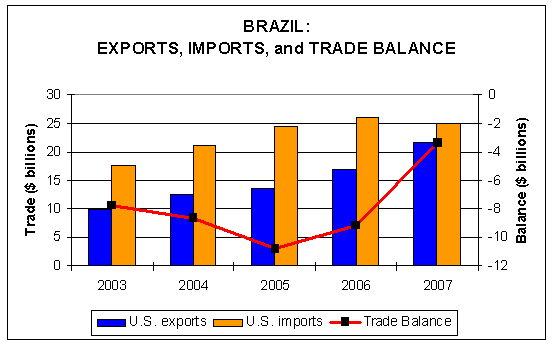View Section in Publication :: Return to Overview

Key Economic Events
- The appreciation of the Brazilian real against the U.S. dollar increased purchasing power for Brazilian consumers, contributing to the increased in U.S. exports to Brazil and decline in the bilateral U.S. trade deficit with Brazil in 2007.
- A broad spectrum of U.S. exports benefitted from Brazil's 5.4 percent growth in GDP. More than one-quarter of the increase in U.S. exports to Brazil were accounted for by deliveries of aircraft for GOL Airlines and aircraft engines for production of Embraer aircraft. Higher global demand and prices for Brazil's agricultural products contributed to the rise in U.S. exports of agricultural chemicals and pesticides to Brazil along with higher prices for those agricultural chemicals.
- About half of the $15.5 billion increase in U.S. merchandise imports in 2006 from Canada resulted from higher energy product imports, and the other half from higher imports of mineral and metal products. U.S. imports of energy products from Canada increased by 12 percent to $73.7 billion in 2006, propelled by higher energy prices across the board. The average price of imported crude petroleum rose by 20 percent to $60 per barrel in 2006.
- U.S. imports from Brazil declined largely due to less demand for imported ethanol in the United States with increased U.S. production. Declines in U.S. truck production also reduced demand for imported motor vehicle engines.
Trade Shifts in 2007 from 2006
- U.S. trade deficit: Decreased by $5.9 billion (64 percent) to $3.3 billion
- U.S. exports: Increased by $4.7 billion (28 percent) to $21.7 billion
- U.S. imports: Decreased by $1.2 billion (4 percent) to $25.0 billion
Other Government Resources
- U.S. Central Intelligence Agency: World Factbook
- U.S. Department of Energy, Energy Information Administration: Country Analysis Brief - Brazil
- U.S. Department of State: Background Note - Brazil


















